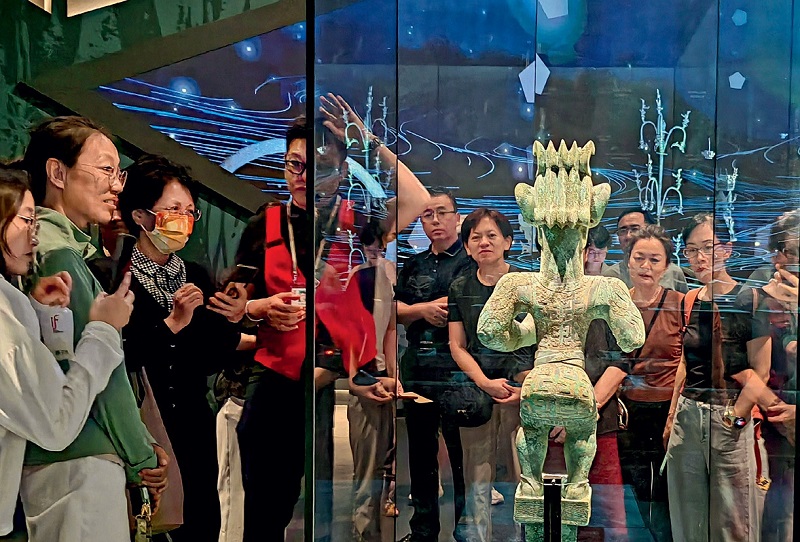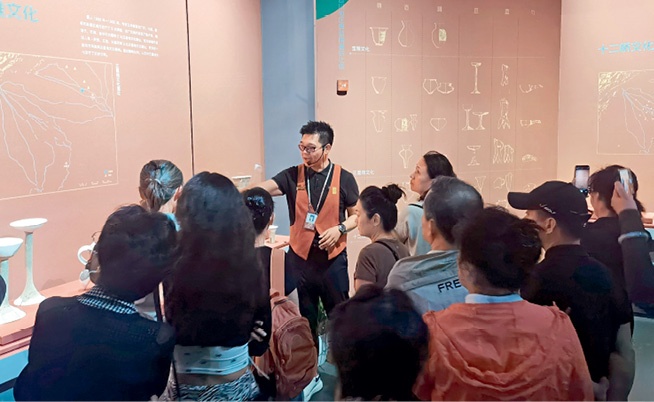A volunteer museum guide stimulates visitors’ curiosity and imagination, leaving them with a deeper understanding of the exhibition themes.
Museums are evolving into popular destinations for young people to engage with history and culture. Xu Nuo is a guide at the Capital Museum in Beijing. In 2024, he completed 50 sessions of volunteer services at the Lao She Memorial and built a volunteer team for the Grand Canal Museum of Beijing (Capital Museum East Branch). Serving as a bridge between visitors and exhibition curators, Xu said he is the catalyst for people to enjoy the “cultural feast” in the museum.

Xu Nuo guides visitors through a special exhibition “Unveiling Sanxingdui and Jinsha of Ancient Shu Civilization” at the Grand Canal Museum of Beijing (Capital Museum East Branch), held in collaboration with the Jinsha Site Museum, on September 1, 2024.
Volunteer Service Team
Xu used to work for a multinational corporation, who organized public brand promotions in collaboration with institutions of cultural relics and intangible cultural heritage. In 2017, he joined Armstrong Music & Arts, an internationally renowned classical music agency and production management company. During a gap year between the two companies, he saw the news that the Capital Museum was recruiting volunteer guides and decided to give it a try. After passing the interview he was given three months of training and set out on his new venture.
“I am a member of the seventh team of volunteers at the Capital Museum. There are over 40 people from various sectors and age groups, including retirees, college students, and working professionals on the team,” Xu told China Today. Their pre-job training covered a wide range of topics, including Beijing’s history, the museum layout, exhibition contents and displays, safety knowledge, and tour-guiding etiquette.
At the end of 2023, the Grand Canal Museum of Beijing was opened to the public. Now a senior volunteer guide, Xu was assigned to train the new team members. They selected more than 30 tour guides from the 100 candidates and trained them according to Capital Museum requirements.
Xu studied every exhibition panel in advance and compiled a 20-plus-page script. “I asked the newcomers to memorize the explanations on the panels and complete an accurate introduction within one hour. The young team members are passionate, and frequently discuss questions in the team’s WeChat group,” Xu said. After passing the final exam, they became the first group of volunteers at the Grand Canal Museum of Beijing.
“Volunteers mean that we are unpaid, but the work is not that easy. We need to complete at least 50 hours of service each year. It’s hard to persist without a genuine passion for it,” Xu said. Initially, he was drawn to the role due to its interesting and meaningful nature. However, over time, positive feedback from visitors became a strong motivating factor and kept him learning.
Nowadays, people who are seeking areas of service to satisfy their self-worth prefer to participate in social upliftment. Meanwhile, to meet the growing needs of the public and address the rising demand for tour-guide services in museums, these institutions are also keen to recruit a large number of volunteer tour guides, Xu explained.
Given the surging number of visitors, many museums have both professional and volunteer guides. The latter come from all walks of life, and have their own strengths – some are passionate about history, while others may have a university major in the arts. They can actively engage visitors in looking at, and talking about the exhibition from their own perspectives.
“Sometimes I would follow other guides to pick up new ideas and methods. I appreciate learning things in an inclusive way,” Xu said. Visitors pose all kinds of questions. Some are professionals who have conducted in-depth research in certain fields and they like having a thorough discussion with the guide. When he is challenged by a tough question, Xu would note it down and later consult an expert. “Museum administrators often help us solve problems. It is an interactive learning process,” Xu said.
In 2024, a blue book of volunteer services was released by the Chinese Academy of Social Sciences and Social Sciences Academic Press. It revealed that an increasing number of museums are adopting a “full-time staff plus volunteers” model, encouraging more museum enthusiasts to join volunteer services. Statistics show that over the past decade, the average number of registered volunteers per museum in China rose from 40 in 2010 to 174 in 2019, demonstrating the public’s growing recognition of museum volunteer services.
Past and Present
“There is no standard script for us. We need to be a critical thinker who can skillfully connect artifacts and concepts with the curator’s intention,” Xu said.
Many guides are history majors. However, for Xu, rather than just providing academic knowledge, it is more important to be a good link between visitors and curators. “It is not just about me speaking and you listening. We prioritize mutual communication to ensure that visitors gain a clear understanding of the exhibition’s essence and the curator’s vision,” Xu added.
“When you see a bronze vessel from the Shang Dynasty, you can learn about the politics and culture of that period and infer the industrial development level at the time, thereby understanding the civilization,” he said.
“The Beijing Central Axis” is a boutique exhibition that Xu has explained more than one hundred times, and each time he will try to bring in a new element. He also identifies some new points of interest from visitors’ inquiries.
Regarding history of the Southern Song Dynasty (1127-1279), Xu said that the Jin Dynasty (1115-1234), founded by the Nüzhen tribes, had moved its capital to Yanjing (present-day Beijing) and renamed it Zhongdu, or the Jin Zhongdu (the central capital).
“Jin Zhongdu may seem like a forgotten name from history, but some of its place names remain in existence in Beijing’s metro stations and public bus lines, such as Fengyi Gate and Malian Dao,” Xu said. To gain a deeper understanding, he delved into history books to learn about the Jin Dynasty and the origins of these place names. In the process he discovered that Fengyi Gate was the south gate of Jin Zhongdu, and to its south stood a sacrificial altar called the Suburban Altar. Gradually, this area has developed as the Fengtai District of Beijing, which actually boasts a history of over 800 years. Through this relationship between visitors and guide, learning and appreciation occurs.
Xu told China Today that the key to this exhibition is understanding the evolution from “center” to “central axis” and then to the “Beijing Central Axis.” In ancient times, the central axis of a capital city formed its heart, with various ceremonial buildings arranged along it on both sides to create the city’s layout. For example, the Bell Tower and Drum Tower kept time for the city, while the Imperial Ancestral Temple and the Altar of Land and Grain served different ritual functions, together constituting a vast system centered on the central axis.
Xu often poses questions to visitors, such as: Does the central axis exist only in Beijing? What roles has the central axis played in different historical periods? Why was the Imperial Ancestral Temple placed here and can it switch positions with the Altar of Land and Grain (now Zhongshan Park)? Visitors manage to find the answers, and can then trace the hundreds of years of Chinese history centered in the capital city and the central axis. In this way they understand that the Chinese civilization has undergone a process of continuous integration and development, the evolution of Chinese ritual systems in particular.

Xu Nuo introduces the archaeological discovery of Sanxingdui and the Jinsha Site, unveiling the mystery of the ancient Shu civilization.
A New Perspective
Beijing, the city of museums, attracts large numbers of foreign visitors who also have an in-depth understanding of Chinese culture.
The Lao She Memorial, located in a Beijing-style courtyard house, was the former residence of Lao She (1899-1966), a notable Chinese writer. Xu provides guide services there once a week, telling the life story of Lao She to visitors from home and abroad.
“I found that many foreign visitors from the United States, France, and many other countries are particularly interested in Lao She. Some of them can speak fluent Chinese, some are studying Chinese language, and some are fond of Chinese culture, or just an admirer of Lao She’s great works, such as the classic novel Camel Xiangzi,” Xu said.
These visitors enjoy discussing Lao She’s life and the characters in his works. “I know that Camel Xiangzi is his most famous work overseas, which has been translated into over 80 languages. Most of the visitors have read it and like having discussions about it,” Xu said.
History, art, and culture – all these are interconnected and evolving, whether it is Chinese or Western, Xu said. The Italian missionary Matteo Ricci (1552-1610) is a historical figure that often sparks the interest of foreign visitors. Ricci came to China during the Wanli reign of the Ming Dynasty (1368-1644). And this connection between Chinese and Western cultures helps audiences understand cultural evolution and mutual exchanges.
The collision and collaboration between Chinese and Western cultures are often seen in exhibitions, constantly imparting new knowledge to Xu. He recalled a joint exhibition with Poland’s National Museum in Krakow, which showcased Polish culture through its oil paintings during the Renaissance. The curator thoughtfully arranged background music for different eras, such as Vivaldi’s The Four Seasons and Bach’s Air on the G String as representatives of the Baroque music, characterized by its grandeur, expressive melodies, and the establishment of tonal harmony.
“I told visitors, please listen to this music and observe the exhibition’s church choirs and sculptures,” Xu said. The immersive experience gave them the illusion that they were in a Baroque-era church, having a holistic understanding of the era and its culture. He further pointed out, “The curator must have conducted in-depth research to make such a perfect match between the music and the visual elements of the artifacts and scenes in the exhibition. This makes the entire exhibition experience very absorbing and thought-provoking.”